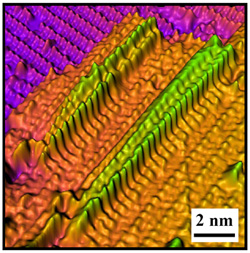Why Is Red Paint Red?
Students at Deerfield High School in suburban Chicago began their chemistry course with an unusual activity: painting. It was part of teacher Lisa Backus’s innovative curriculum designed to engage students in science through the exploration of art — a curriculum inspired by her summer research experience at Northwestern.
Last summer was Backus’s third participating in the Materials Research Center’s Research Experience for Teachers, a program that invites science teachers to spend the summer working in a Northwestern professor’s lab. Backus split her time between the lab of Katherine Faber, professor of materials science and engineering at Northwestern, performing materials analysis on ancient Chinese jades, and working with Francesca Casadio, Andrew W. Mellon Conservation Scientist at the Art Institute of Chicago, studying pigments in watercolors by American painter Winslow Homer. During her research Backus also spent time developing ideas she could take back to her classroom.
While at Northwestern, Backus found additional inspiration for her art-based curriculum in a somewhat unlikely venue — a seminar on nanotechnology led by Mark Hersam, professor of materials science and engineering. “Listening to Mark, I began to realize that there was a strong connection to art. The more I learned about nanotechnology, the more I saw how many art techniques they are using. They’re stamping, printing, and using lithography.”
Backus developed those thoughts into a nine-week curriculum including lessons such as “Why Is Red Paint Red?” and “The Art of Science and the Science of Art.” Students began the unit by painting posters about lab safety, then were challenged to create their own paints from natural materials. Their attempts — using materials such as honey, marshmallow fluff, spices, and flowers — led to a discussion of the fundamentals of pigment and what gives rise to color. Students explored atoms, transition metals, light, reflection, and absorption in their search to understand pigment. According to Backus, the practical applications of the curriculum helped to engage students in the hard science they covered along the way.
“No one says ‘Who cares?’ or ‘Why do we need to know this?’ because the entire time we were trying to figure out why the paint was red,” Backus explains. “That helps people who aren’t science driven. We learned a lot of heavy chemistry without feeling like we were learning heavy chemistry.”
After gaining an understanding of the fundamentals of paint and color, students explored a variety of art techniques, such as photolithography (sun prints), wax stamping, stamp rolling, and spin coating. Then, using a presentation that Hersam developed for Northwestern’s National Center for Learning and Teaching in Nanoscale Science, Backus showed students how top-level scientists use some of those same techniques when studying nanotechnology.
“That lecture is really in-depth, but we had done all of these things,” Backus says. “It helps to be able to say, ‘This is from Northwestern, and look at what they’re doing: They’re doing stamp rolling and photolithography, just like we’ve been doing in class.’”
Backus is excited to use the new curriculum again next year and may share it with her colleagues. Her success comes as no surprise to Faber. “At the end of the summer, I was really blown over by what Lisa had done,” Faber says. “She had the whole study unit laid out in terms of what I think is really important — the method of inquiry. She starts with the basics of paint, then discusses what makes a good paint, and then explores the chemistry at work. Hearing about the sophisticated synthesis analytical techniques at Northwestern, she was able to come up with clever classroom activities. It was inspiring listening to her plans.”
